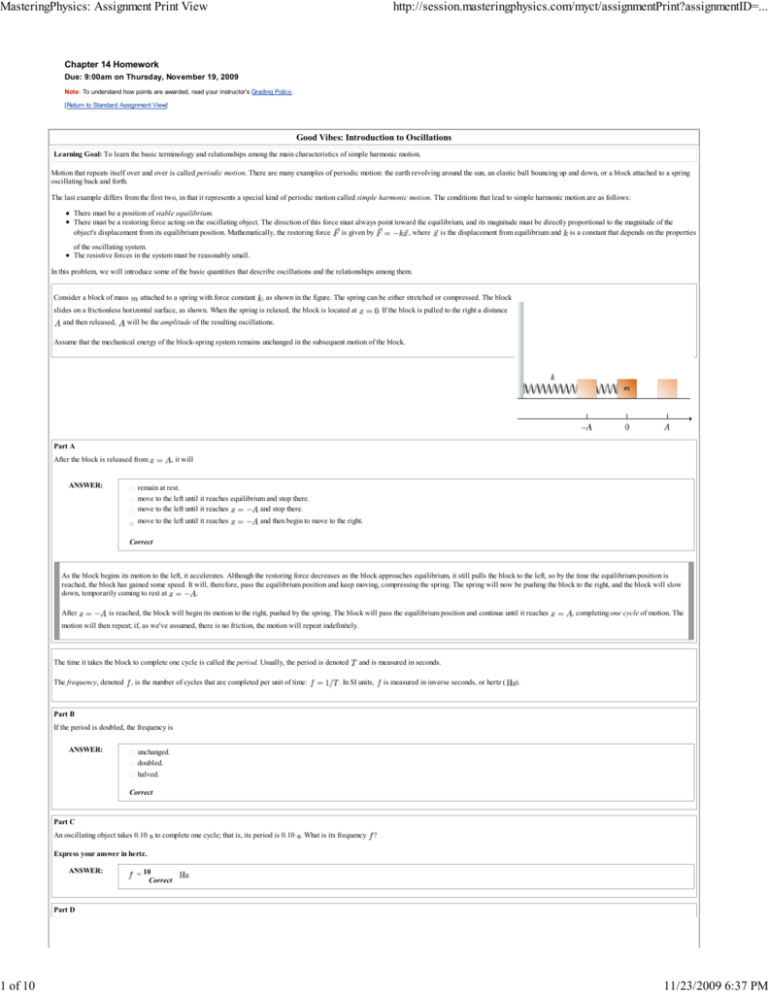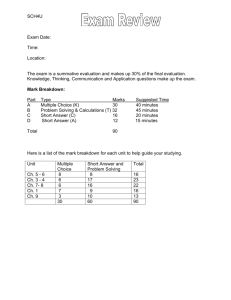MasteringPhysics: Assignmen
advertisement

MasteringPhysics: Assignment Print View 1 of 10 http://session.masteringphysics.com/myct/assignmentPrint?assignmentID=... Chapter 14 Homework Due: 9:00am on Thursday, November 19, 2009 Note: To understand how points are awarded, read your instructor's Grading Policy. [Return to Standard Assignment View] Good Vibes: Introduction to Oscillations Learning Goal: To learn the basic terminology and relationships among the main characteristics of simple harmonic motion. Motion that repeats itself over and over is called periodic motion. There are many examples of periodic motion: the earth revolving around the sun, an elastic ball bouncing up and down, or a block attached to a spring oscillating back and forth. The last example differs from the first two, in that it represents a special kind of periodic motion called simple harmonic motion. The conditions that lead to simple harmonic motion are as follows: There must be a position of stable equilibrium. There must be a restoring force acting on the oscillating object. The direction of this force must always point toward the equilibrium, and its magnitude must be directly proportional to the magnitude of the object's displacement from its equilibrium position. Mathematically, the restoring force is given by , where is the displacement from equilibrium and is a constant that depends on the properties of the oscillating system. The resistive forces in the system must be reasonably small. In this problem, we will introduce some of the basic quantities that describe oscillations and the relationships among them. Consider a block of mass attached to a spring with force constant , as shown in the figure. The spring can be either stretched or compressed. The block slides on a frictionless horizontal surface, as shown. When the spring is relaxed, the block is located at and then released, . If the block is pulled to the right a distance will be the amplitude of the resulting oscillations. Assume that the mechanical energy of the block-spring system remains unchanged in the subsequent motion of the block. Part A After the block is released from ANSWER: , it will remain at rest. move to the left until it reaches equilibrium and stop there. move to the left until it reaches and stop there. move to the left until it reaches and then begin to move to the right. Correct As the block begins its motion to the left, it accelerates. Although the restoring force decreases as the block approaches equilibrium, it still pulls the block to the left, so by the time the equilibrium position is reached, the block has gained some speed. It will, therefore, pass the equilibrium position and keep moving, compressing the spring. The spring will now be pushing the block to the right, and the block will slow down, temporarily coming to rest at . After is reached, the block will begin its motion to the right, pushed by the spring. The block will pass the equilibrium position and continue until it reaches , completing one cycle of motion. The motion will then repeat; if, as we've assumed, there is no friction, the motion will repeat indefinitely. The time it takes the block to complete one cycle is called the period. Usually, the period is denoted The frequency, denoted , is the number of cycles that are completed per unit of time: and is measured in seconds. . In SI units, is measured in inverse seconds, or hertz ( ). Part B If the period is doubled, the frequency is ANSWER: unchanged. doubled. halved. Correct Part C An oscillating object takes 0.10 to complete one cycle; that is, its period is 0.10 . What is its frequency ? Express your answer in hertz. ANSWER: = 10 Correct Part D 11/23/2009 6:37 PM MasteringPhysics: Assignment Print View 2 of 10 If the frequency is 40 , what is the period http://session.masteringphysics.com/myct/assignmentPrint?assignmentID=... ? Express your answer in seconds. ANSWER: = 0.025 Correct The following questions refer to the figure that graphically depicts the oscillations of the block on the spring. Note that the vertical axis represents the x coordinate of the oscillating object, and the horizontal axis represents time. Part E Which points on the x axis are located a distance ANSWER: from the equilibrium position? R only Q only both R and Q Correct Part F Suppose that the period is ANSWER: . Which of the following points on the t axis are separated by the time interval ? K and L K and M K and P L and N M and P Correct Now assume that the x coordinate of point R is 0.12 and the t coordinate of point K is 0.0050 . Part G What is the period Hint G.1 ? How to approach the problem In moving from the point to the point K, what fraction of a full wavelength is covered? Call that fraction . Then you can set . Dividing by the fraction will give the period . Express your answer in seconds. ANSWER: = 0.02 Correct Part H How much time does the block take to travel from the point of maximum displacement to the opposite point of maximum displacement? Express your answer in seconds. ANSWER: = 0.01 Correct Part I What distance does the object cover during one period of oscillation? Express your answer in meters. ANSWER: = 0.48 Correct Part J What distance does the object cover between the moments labeled K and N on the graph? Express your answer in meters. ANSWER: = 0.36 Correct 11/23/2009 6:37 PM MasteringPhysics: Assignment Print View 3 of 10 http://session.masteringphysics.com/myct/assignmentPrint?assignmentID=... Position, Velocity, and Acceleration of an Oscillator Learning Goal: To learn to find kinematic variables from a graph of position vs. time. The graph of the position of an oscillating object as a function of time is shown. Some of the questions ask you to determine ranges on the graph over which a statement is true. When answering these questions, choose the most complete answer. For example, if the answer "B to D" were correct, then "B to C" would technically also be correct--but you will only recieve credit for choosing the most complete answer. Part A Where on the graph is ANSWER: ? A to B A to C C to D C to E B to D A to B and D to E Correct Part B Where on the graph is ANSWER: ? A to B A to C C to D C to E B to D A to B and D to E Correct Part C Where on the graph is ANSWER: ? A only C only E only A and C A and C and E B and D Correct Part D Where on the graph is the velocity Hint D.1 ? Finding instantaneous velocity Instantaneous velocity is the derivative of the position function with respect to time, . Thus, you can find the velocity at any time by calculating the slope of the ANSWER: vs. graph. When is the slope greater than 0 on this graph? A to B A to C C to D C to E B to D A to B and D to E Correct Part E Where on the graph is the velocity ? 11/23/2009 6:37 PM MasteringPhysics: Assignment Print View 4 of 10 http://session.masteringphysics.com/myct/assignmentPrint?assignmentID=... Energy of Harmonic Oscillators A to B A to C Learning Goal: To learn to apply the law of conservation of energy to the analysis of harmonic oscillators. C to D C to E or harmonic oscillators, obey the law of conservation of energy just like all other systems do. Using energy considerations, one can analyze many aspects of motion of the oscillator. Systems in simple harmonic motion, Such an analysis can be simplified B to Dif one assumes that mechanical energy is not dissipated. In other words, A to B and D to E , ANSWER: where Correct is the total mechanical energy of the system, is the kinetic energy, and is the potential energy. As you know, a common example of a harmonic oscillator is a mass attached to a spring. In this problem, we will consider a horizontally moving block attached to a spring. Note that, since the gravitational potential Part F energy is not changing in this case, it can be excluded from the calculations. Where on the graph is the velocity ? For such a system, the potential energy is stored in the spring and is given by Hint F.1 How to tell if , Hint not displayed where is the force constant of the spring and is the distance from the equilibrium position. ANSWER: A only The kinetic energy of the system is, as always, B only C only D only E only where is the mass of the block is the speed of the block. A andand C A and C and E We will also assume that there are no resistive forces; that is, . B and D , Correct Consider a harmonic oscillator at four different moments, labeled A, B, C, and D, as shown in the figure . Assume that the force constant , the mass of the block, , and the amplitude of vibrations, Part G , are given. Answer the following questions. Where on the graph is the acceleration ? Hint G.1 Finding acceleration Acceleration is the second derivative of the position function with respect to time: . This means that the sign of the acceleration is the same as the sign of the curvature of the x vs. t graph. The acceleration of a curve is negative for downward curvature and positive for upward curvature. Where is the curvature greater than 0? Part ANSWER: A A to B A to Which moment corresponds to theCmaximum potential energy of the system? C to D Hint A.1 Consider C tothe E position of the block B to D A to B and D to E ANSWER: Part H Hint not displayed A Correct B C D Where on the graph is the acceleration Correct ? ANSWER: Part B A to B A to C Which moment corresponds to theDminimum kinetic energy of the system? C to Hint B.1 C to E How does the velocity change? B to D A to B and D to E Correct A B C Part I D Where on the graph is the acceleration Hint not displayed ANSWER: Hint I.1 ? Correct How to tell if When the block is displaced a distance that moment, of course, ANSWER: Hint not displayed from equilibrium, the spring is stretched (or compressed) the most, and the block is momentarily at rest. Therefore, the maximum potential energy is . Recall that . At . Therefore, A only B only . C only D only In general, the mechanicalEenergy only of a harmonic oscillator equals its potential energy at the maximum or minimum displacement. A and C A and C and E Part C B and D Consider the block in the process of oscillating. Correct 11/23/2009 6:37 PM MasteringPhysics: Assignment Print View 5 of 10 http://session.masteringphysics.com/myct/assignmentPrint?assignmentID=... ANSWER: If the kinetic energy of the block is increasing, the block must be at the equilibrium position. at the amplitude displacement. moving to the right. moving to the left. moving away from equilibrium. moving toward equilibrium. Correct Part D Which moment corresponds to the maximum kinetic energy of the system? Hint D.1 Consider the velocity of the block Hint not displayed ANSWER: A B C D Correct Part E Which moment corresponds to the minimum potential energy of the system? Hint E.1 Consider the distance from equilibrium Hint not displayed ANSWER: A B C D Correct When the block is at the equilibrium position, the spring is not stretched (or compressed) at all. At that moment, of course, kinetic energy can then be written as . Recall that and that . Meanwhile, the block is at its maximum speed ( ). The maximum at the equilibrium position. Therefore, . Recalling what we found out before, , we can now conclude that , or . Part F At which moment is Hint F.1 ? Consider the potential energy At this moment, . Use the formula for ANSWER: to obtain the corresponding distance from equilibrium. A B C D Correct Part G Find the kinetic energy Hint G.1 of the block at the moment labeled B. How to approach the problem Find the potential energy first; then use conservation of energy. Hint G.2 Find the potential energy 11/23/2009 6:37 PM MasteringPhysics: Assignment Print View 6 of 10 Find the potential energy http://session.masteringphysics.com/myct/assignmentPrint?assignmentID=... of the block at the moment labeled B. Express your answer in terms of and . ANSWER: = Correct Using the facts that the total energy Express your answer in terms of and and that , you can now solve for the kinetic energy at moment B. . ANSWER: = Correct Cosine Wave The graph shows the position of an oscillating object as a function of time . The equation of the graph is , where is the amplitude, is the angular frequency, and is a phase constant. The quantities , , and are measurements to be used in your answers. Part A What is in the equation? Hint A.1 Maximum of Hint not displayed ANSWER: Correct Part B What is in the equation? Hint B.1 Period Hint not displayed ANSWER: Correct Part C What is in the equation? Hint C.1 What is Using the graph and trigonometry equal to when Hint C.2 ? Use your result for to solve for in terms of , , and . Using the graph and Part B You might be able to find in terms of and then use your result from Part B. ANSWER: 11/23/2009 6:37 PM MasteringPhysics: Assignment Print View 7 of 10 http://session.masteringphysics.com/myct/assignmentPrint?assignmentID=... Correct Analyzing Simple Harmonic Motion This applet shows two masses on springs, each accompanied by a graph of its position versus time. Part A What is an expression for Hint A.1 , the position of mass I as a function of time? Assume that position is measured in meters and time is measured in seconds. How to approach the problem The most general form of a sinusoidal wave is or , depending upon whether you write the equation using the sine or cosine. Notice that the amplitude , however, will be different, since for any The amplitude and angular frequency , we have the relation and the angular frequency will be the same regardless of whether you choose to use sine or cosine. The phase . can be determined directly from the graph. The decision whether to use sine or cosine is more a matter of convenience. Which of the following statements correctly identify a choice of function and phase that could be used to describe this graph? Check all that apply. ANSWER: cosine, cosine, cosine, sine, sine, sine, Answer Requested Of the three correct options, the simplest is cosine with phase shift zero, but any of them will give the correct answer. Hint A.2 Find the amplitude What is the amplitude Hint A.2.1 of the motion of the first mass? Definition of amplitude Hint not displayed Express your answer in meters to two significant figures. ANSWER: Hint A.3 =1 Correct Find the angular frequency What is the angular frequency Hint A.3.1 of the motion of the first mass? Angular frequency and frequency Hint not displayed Express your answer in radians per second to three significant figures. ANSWER: = 12.6 Correct Express your answer as a function of . Express numerical constants to three significant figures. ANSWER: = Correct Part B What is Hint B.1 , the position of mass II as a function of time? Assume that position is measured in meters and time is measured in seconds. How to approach the problem Hint not displayed Hint B.2 Find the amplitude Hint not displayed Hint B.3 Find the angular frequency Hint not displayed 11/23/2009 6:37 PM MasteringPhysics: Assignment Print View 8 of 10 http://session.masteringphysics.com/myct/assignmentPrint?assignmentID=... Express your answer as a function of . Express numerical constants to three significant figures. ANSWER: = Correct Changing the Period of a Pendulum A simple pendulum consisting of a bob of mass attached to a string of length swings with a period . Part A If the bob's mass is doubled, approximately what will the pendulum's new period be? Hint A.1 Period of a simple pendulum Hint not displayed ANSWER: Correct Part B If the pendulum is brought on the moon where the gravitational acceleration is about Hint B.1 , approximately what will its period now be? How to approach the problem Hint not displayed ANSWER: Correct Part C If the pendulum is taken into the orbiting space station what will happen to the bob? Hint C.1 How to approach the problem Hint not displayed ANSWER: It will continue to oscillate in a vertical plane with the same period. It will no longer oscillate because there is no gravity in space. It will no longer oscillate because both the pendulum and the point to which it is attached are in free fall. It will oscillate much faster with a period that approaches zero. Correct In the space station, where all objects undergo the same acceleration due to the earth's gravity, the tension in the string is zero and the bob does not fall relative to the point to which the string is attached. Gravity on Another Planet After landing on an unfamiliar planet, a space explorer constructs a simple pendulum of length 53.0 . The explorer finds that the pendulum completes 94.0 full swing cycles in a time of 131 . Part A What is the value of the acceleration of gravity on this planet? Hint A.1 How to approach the problem Calculate the period of the pendulum, and use this to calculate the gravitational acceleration on the planet. Hint A.2 Calculate the period Calculate the period of the pendulum. Express your answer in seconds. ANSWER: Hint A.3 = 1.39 Correct Equation for the period The period of a simple pendulum is given by the equation , where is the length of the pendulum and is the gravitational acceleration on the planet. Express your answer in meters per second per second. 11/23/2009 6:37 PM MasteringPhysics: Assignment Print View 9 of 10 ANSWER: http://session.masteringphysics.com/myct/assignmentPrint?assignmentID=... = 10.8 Correct Problem 14.26 A 2.0 g spider is dangling at the end of a silk thread. You can make the spider bounce up and down on the thread by tapping lightly on his feet with a pencil. You soon discover that you can give the spider the largest amplitude on his little bungee cord if you tap exactly once every second. Part A What is the spring constant of the silk thread? ANSWER: 7.90×10−2 Correct Damped Egg on a Spring A 50.0- hard-boiled egg moves on the end of a spring with force constant amplitude of the motion has decreased to 0.100 . It is released with an amplitude 0.300 . A damping force acts on the egg. After it oscillates for 5.00 , the . Part A Calculate the magnitude of the damping coefficient . Hint A.1 How damped is it? The system described above is ___________. Hint A.1.1 How to determine damping Hint not displayed ANSWER: critically damped overdamped underdamped Correct Hint A.2 What formula to use In this problem, the motion is described by the general equation for an underdamped oscillator, , where , is position, and Hint A.3 is time. The displacement is thus a product of a oscillating cosine term and a damping term . This equation is the solution to the damped oscillator equation . Find the amplitude What is , the amplitude as a function of time? Use Hint A.3.1 for the initial displacement of the system and for the mass of the egg. Initial amplitude Hint not displayed Give your answer in terms of , , , and . ANSWER: = Correct Now evaluate Hint A.4 If and set your answer equal to 0.100 Solving for as given in the problem introduction. Finally, solve for . in then Express the magnitude of the damping coefficient numerically in kilograms per second, to three significant figures. ANSWER: −2 = 2.20×10 kg/s Correct Problem 14.70 An oscillator with a mass of 500 and a period of 0.900 has an amplitude that decreases by 2.20% during each complete oscillation. Part A If the initial amplitude is 10.6 , what will be the amplitude after 37.0 oscillations? 11/23/2009 6:37 PM MasteringPhysics: Assignment Print View 10 of 10 ANSWER: http://session.masteringphysics.com/myct/assignmentPrint?assignmentID=... 4.65 Correct Part B At what time will the energy be reduced to 54.0% of its initial value? ANSWER: 12.5 Correct Score Summary: Your score on this assignment is 105%. You received 63.47 out of a possible total of 65 points, plus 4.8 points of extra credit. 11/23/2009 6:37 PM




